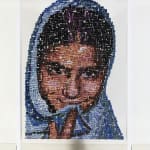Reena Saini Kallat Indian, b. 1973
195.6 x 134.6 cm
Width of Base 10 in (25.4 cm)
Further images
-
(View a larger image of thumbnail 1
)

-
(View a larger image of thumbnail 2
)

-
(View a larger image of thumbnail 3
)

-
(View a larger image of thumbnail 4
)

-
(View a larger image of thumbnail 5
)

-
(View a larger image of thumbnail 6
)

-
(View a larger image of thumbnail 7
)

-
(View a larger image of thumbnail 8
)

From a distance they come together as portraits, but up-close they almost seem like a circuit-board of rubberstamps. The rubberstamps are made with names of those officially registered as having gone missing in India from different geographical zones. These include names of those lost either through natural calamities such as landslides, floods, earthquakes; or gone missing during riots or large scale mishaps; names of those abducted or absconding, with the police still trying to ascertain their whereabouts.
These are people who seem to have slipped out of the radar of human communication, thrown off the social safety net. The portrait of a sub-continental citizen is formed by numerous such names; the back of each portrait appearing like a sea of invisible identities, a bird’s eye view of a large human congregation.
Synonym’ invokes the vulnerability of the citizen in the face of a megalopolis, a state or a federation, which habitually treats them as abstract statistics or names in a record book. The works stand like screens holding up portraits formed by several hundred names of people rendered in over 14 Indian languages. From a distance they come together as portraits, but up-close their animated eyes and mouths quickly disintegrate, like pixilated images, reducing each lively feature to a circuit-board of stamps announcing a universe of names.
The rubberstamps carry names of people officially registered as having gone missing in India from different geographical zones. These are people who seem to have slipped out of the radar of human communication, thrown off the social safety net. The portrait of a sub-continental citizen is formed by numerous such names; the back of each portrait appearing like a sea of invisible identities, a bird’s eye view of a large human congregation.
The quiet containment of the work, its discreet enlistment of names echoes the political logic of a democracy which operates on the framework of a ‘whole composed of fractions’ discourse. Metaphorically, the nation-state, much like the images in ‘Synonym’, is a complex portrait composed of billions of pieces of mosaic units. On paper, a democracy enfranchises every citizen, granting each of them a say and a share in electoral power. In practice however, its depth and expanse quickly consumes the individual entity, rendering them (and, in the process, their individual rights) invisible. This constant disappearance of citizens in the crevices of the intricate grooves of the bureaucratic machinery is what haunts the faces portrayed.
Exhibitions
2011 Samtidigt, Helsinki City Art Museum, Finland | 2010 The Empire Strikes Back, Saatchi Gallery, London | 2009 View Points and Viewing points – 2009 Asian Art Biennale, National Taiwan Museum of Fine Arts | 2009 Chalo! India: A New Era of Indian Art, National Museum of Contemporary Art, Korea and Essl Museum, Vienna | 2009 INDIA XIANZAI: Contemporary Indian Art, Museum of Contemporary Art, Shanghai | 2008 Chalo! India: A New Era of Indian Art, Mori Art Museum, Japan







